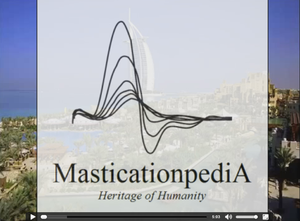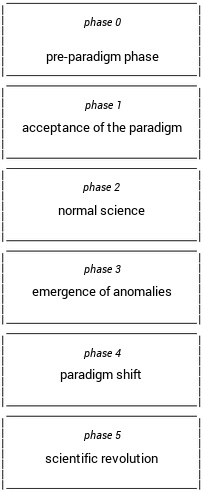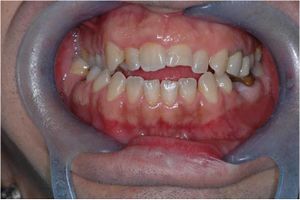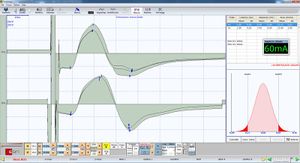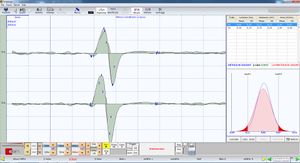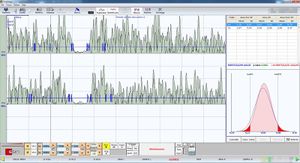Difference between revisions of "Introduction/pt"
Gianfranco (talk | contribs) (Created page with "'''Epistemologia''' (do grego ἐπιστήμη, ''epistème'', "certo conhecimento" ou "ciência", e λόγος, ''logos'', "discurso") é aquele ramo da filosofia que lida c...") |
Gianfranco (talk | contribs) (Created page with "Acredita-se que o termo tenha sido cunhado pelo filósofo escocês James Frederick Ferrier em seu ''Institutos de Metafísica''") |
||
| Line 133: | Line 133: | ||
---- | ---- | ||
| − | '''Epistemologia''' (do grego ἐπιστήμη, ''epistème'', "certo conhecimento" ou "ciência", e λόγος, ''logos'', "discurso") é aquele ramo da filosofia que lida com o as condições sob as quais o conhecimento científico pode ser obtido e os métodos para alcançá-lo.<ref> | + | '''Epistemologia''' (do grego ἐπιστήμη, ''epistème'', "certo conhecimento" ou "ciência", e λόγος, ''logos'', "discurso") é aquele ramo da filosofia que lida com o as condições sob as quais o conhecimento científico pode ser obtido e os métodos para alcançá-lo.<ref>Acredita-se que o termo tenha sido cunhado pelo filósofo escocês James Frederick Ferrier em seu ''Institutos de Metafísica'' (p.46), of 1854; see Internet Encyclopedia of Philosophy, ''[https://www.iep.utm.edu/ferrier/ James Frederick Ferrier (1808—1864)]''. [[:wikipedia:James Frederick Ferrier|Wikipedia]]</ref> The term specifically indicates that part of gnoseology which studies the foundations, validity and limits of scientific knowledge. In English-speaking countries, the concept of epistemology is instead mainly used as a synonym for gnoseology or knowledge theory — the discipline that deals with the study of knowledge. |
Incidentally, the basic problem of epistemology today, as in Hume’s time, remains that of verifiability.<ref>[[:wikipedia:David Hume|David Hume]] (Edimburgh, 7 may 1711 – Edimburgh, 25 august 1776) was a Scottish philosopher. He is considered the third and perhaps the most radical of the British Empiricists, after the Englishman John Locke and the Anglo-Irish George Berkeley.</ref><ref>{{cita libro | Incidentally, the basic problem of epistemology today, as in Hume’s time, remains that of verifiability.<ref>[[:wikipedia:David Hume|David Hume]] (Edimburgh, 7 may 1711 – Edimburgh, 25 august 1776) was a Scottish philosopher. He is considered the third and perhaps the most radical of the British Empiricists, after the Englishman John Locke and the Anglo-Irish George Berkeley.</ref><ref>{{cita libro | ||
Revision as of 13:32, 27 January 2021
Gostaríamos que nosso leitor tivesse uma percepção imediata dos temas que serão debatidos em Masticationpedia; revisaremos algumas das questões mais atuais relativas à evolução epistemológica da ciência em geral, e da medicina médica e odontológica em particular. You are not logged in, you cannot watch the video here on the left, but you can read this page.
Nesta fase consideraremos dois aspectos fundamentais do Progresso da Ciência, segundo os Paradigmas de Kuhn, e Epistemologia que questiona os conceitos de "Inferência Estatística" e "Interdisciplinaridade".
Esses dois temas, que aparentemente parecem estar em conflito um com o outro, já que o primeiro precisa de disciplinaridade para destacar as "Anomalias no Paradigma" e o segundo precisa de "Interdisciplinaridade", eles se integrarão através um elemento de resolução que consiste em "andaimes metacognitivos", isto é, pontes cognitivas entre disciplinas especializadas. Neste contexto, portanto, o leitor poderá apreciar melhor a abordagem estocástica em relação a um dos tópicos mais polêmicos em reabilitações mastigatórias, como, "Maloclusão", de onde vem a maior parte os procedimentos de reabilitação mastigatória como ortodontia, prótese e cirurgia ortognática.
Assim, além de nos anteciparmos ao aspecto científico e filosófico da Masticationpedia, enfocaremos finalmente em tópicos como "Sistemas Complexos", o "Comportamento Emergente" de Sistemas Complexos e "Coerência de Sistemas": passos necessários para introduzir tópicos clínicos científicos que trazem com eles dúvidas, questionamentos e ao mesmo tempo inovações paradigmáticas que tendem a mudar o status quo da rotina do pensamento clínico determinista e reducionista, perante uma lógica de linguagem estocástica e interdisciplinar.
Article by Gianni Frisardi
|
Ab ovo[1]
Antes de chegar ao cerne do tratamento da Masticationpedia, cabe uma premissa, que diz respeito principalmente a dois aspectos da realidade social, científica e clínica da era atual e da época imediatamente anterior.
No século passado, testemunhamos um crescimento exponencial em "inovações" tecnológicas e metodológicas, especificamente em odontologia.[2]; essas inovações têm de alguma forma influenciado estratégias de tomada de decisão, opiniões, escolas de pensamento e axiomas a fim de melhorar a qualidade de vida, conforme afirmado na "Exposure Science in the 21st Century"[3]. No entanto, esse crescimento exponencial traz consigo, implicitamente, áreas cinzentas conceituais (em termos práticos "efeitos colaterais") que às vezes são subestimadas, mas que podem questionar algumas certezas científicas ou torná-las menos absolutas e mais probabilísticas.[4]
Os dois aspectos sensíveis da atual realidade social, científica e clínica (que parecem conflitar entre si, mas como veremos no final desta leitura serão complementares) são o "Progresso da Ciência" segundo Kuhn e o "Epistemologia".
Progresso da Ciência de acordo com Thomas Kuhn
Thomas Kuhn em sua obra mais famosa afirma que "a ciência passa ciclicamente por algumas fases indicativas de seu funcionamento".[5][6] De acordo com Kuhn, a ciência é paradigmática, e a demarcação entre ciência e pseudociência pode ser traçada até a existência de um paradigma. A evolução do progresso científico é assimilada a uma curva contínua que sofre descontinuidade nas mudanças de paradigma. Por exemplo, na fase 2 dos Paradigmas de Kuhn, chamada de Ciência Normal, os cientistas são vistos como solucionadores de problemas, que trabalham para melhorar a concordância entre o paradigma e a natureza.
Esta fase, de facto, assenta num conjunto de princípios básicos ditados pelo paradigma, que não são questionados mas aos quais, sim, se incumbem a tarefa de indicar as coordenadas das obras que se seguem. Nesta fase, são desenvolvidos os instrumentos de medição com os quais os experimentos são feitos, a maioria dos artigos científicos é produzida e seus resultados constituem um crescimento significativo do conhecimento científico. Na fase normal da ciência, tanto os sucessos quanto os fracassos serão alcançados; as falhas são chamadas por Kuhn de anomalias ou eventos que vão contra o paradigma.
Como um bom solucionador de problemas, o cientista tenta resolver essas anomalias.
Kuhn, no entanto, divide a evolução de um paradigma em cinco fases; este é um processo fundamental para a Masticationpedia, mas para nos mantermos atentos ao projeto, limitar-nos-emos a descrever as duas fases mais significativas:
| |
|
É quase óbvio que a filosofia científica kuhniana prefere a disciplinaridade, já que uma anomalia no paradigma genômico será melhor percebida por um geneticista do que por um neurofisiologista. Agora, esse conceito parece estar em contraste com a evolução epistemológica da Ciência, então é melhor parar um minuto sobre ele em detalhes.
Epistemologia
| O cisne negro simboliza um dos problemas históricos da epistemologia: se todos os cisnes que vimos até agora são brancos, podemos decidir que todos os cisnes são brancos? Jura? |
|
| Kuhn usou a ilusão de ótica para demonstrar como uma mudança de paradigma pode fazer com que uma pessoa veja a mesma informação de uma maneira completamente diferente: qual animal é o que está aqui de lado? Certo? |
Epistemologia (do grego ἐπιστήμη, epistème, "certo conhecimento" ou "ciência", e λόγος, logos, "discurso") é aquele ramo da filosofia que lida com o as condições sob as quais o conhecimento científico pode ser obtido e os métodos para alcançá-lo.[7] The term specifically indicates that part of gnoseology which studies the foundations, validity and limits of scientific knowledge. In English-speaking countries, the concept of epistemology is instead mainly used as a synonym for gnoseology or knowledge theory — the discipline that deals with the study of knowledge.
Incidentally, the basic problem of epistemology today, as in Hume’s time, remains that of verifiability.[8][9]
The Hempel paradox tells us that each sighted white swan confirms that crows are black[10]; that is, each example not in contrast with the theory confirms a part of it:
According to the objection of falsifiability, instead, no theory is ever true because, while there are only a finite number of experiments in favour, there is also theoretically an infinite number that could falsify it.[11]
|
But it’s not all so obvious... |
...because the very concept of epistemology meets continuous implementations, like in medicine:
|
|
Anomaly vs. Interdisciplinarity
Given the above, on a superficial view of the epistemic evolution of the Science, the two aspects of disciplinarity ("Physics Paradigm of Science", highlighting the anomaly) and Interdisciplinary ("Engineering Paradigm of Science", metacognitive scaffold), might seem to be in conflict with each other; in reality, however, as we are just going to see right in this chapter, they are two sides of the same coin because both tend to generate "Paradigmatic Innovation" without any conflict at all.
Now we could conclude that the "Innovations" are already "Progress of Science" in themselves, as stated in the article "Scientific basis of dentistry" by Yegane Guven, in which the effect of biological and digital revolutions is considered on dental education and daily clinical practice, such as personalized regenerative dentistry, nanotechnologies, virtual reality simulations, genomic information and stem cell studies.[21] The innovations mentioned by Guven are obviously to be considered as technological and methodological in nature; however, the Progress of Science does not move forward with this kind of Innovations, which are called "Incremental Innovations" and "Radical Innovations", but it occurs substantially through "Paradigmatic Innovations".
In the strictest sense of the phrase, "Paradigmatic Innovations" are essentially a change of thought and awareness that pervades the whole of humanity, starting from different social strata, from the Copernican scientific revolution to the current trend of Stochastic approach to the biological phenomenon[22].
In this epistemological context (in addition to other initiatives such as the Research Diagnostic Criteria in the field of the Temporomandibular Disorders — RDC/TMDs), of the Evidence Based Medicine (and other), the Masticationpedia project inserts itself in order to highlight the dialectics dynamism about the progress of the masticatory rehabilitation science. Masticationpedia tends, moreover, to highlight the anomalies that inevitably stimulate a change of thought and therefore a "Paradigmatic Innovation".
Before proceeeding, it could be appropriate to observe a very concrete and significant case.
Malocclusion
Malocclusion: it literally means a bad (malum, in Latin) closure of the dentition[23]. The closure is easy to understand, we believe, but the epithet "bad" must be understood with care as well, because it is not as simple as it seems.
To briefly grasp the concept, in this first introductory reading we will try to present a simple but highly debatable question that involves a series of other questions in the field of masticatory rehabilitation and especially in orthodontic disciplines: what is "Malocclusion"? Bear in mind that in 2019, a Pubmed query about this term returned a result of "only" 33,309 articles[24], which says it all about the hypothetical terminological agreement on the subject; and, therefore, very meaningful conclusions could be drawn every now and then from these articles, such as the ones we reproduce in full from an article by Smaglyuk and collaborators, a somewhat "sensational" article that deals with the interdisciplinary approach in the diagnosis of malocclusions[25]:
Another noteworthy fact is that if in the same 2019 Pubmed was questioned on interdisciplinarity in the diagnosis of malocclusions, the result dropped drastically to just four articles[26].
These premises to the "Malocclusion” question indicate, on one hand, an alert about anomalies that tend to activate Kuhn phase 4 and, on the other, a bifurcation in the epistemic choice on the subject: one that generates Incremental Innovations (others 33,309 articles, perhaps) and another that prefers a new gnoseological path of "Paradigmatic Innovation”.
Let’s try to approach part of the concept that considers the "Paradigmatic Innovation” as essential, asking ourselves for example:
|
What does "Malocclusion" mean? |
We will answer this question by reporting a clinical case of evident “Malocclusion”.
Patient is with an occlusion that orthodontists call “Malocclusion” because it has a posterior unilateral crossbite and anterior openbite[27]; it is a malocclusion that can be treated with a fixed orthodontic therapy and possibly in combination with an orthognathic intervention[28]. Crossbite is another element of disturbance in normal occlusion because of which it is obligatorily treated together with the openbite[29][30][31].
It is self-evident that an observer with a deterministic mindset facing a phenomenon of such evident occlusal incongruity considers crossbite and openbite the cause of malocclusion (cause/effect) or vice versa; and it is obvious, as well, that the observer recommends an orthodontic treatment to restore a “Normocclusion”. This way of reasoning means that the model (masticatory system) is “normalized to occlusion”; and if read backwards, it means that the occlusal discrepancy is the cause of malocclusion and, therefore, of disease of the Masticatory System. (Figure 1a).
But let's hear what the two players say, the dentist and the patient, in the informative dialogue.
| The dentist tells the patient that he is suffering from severe malocclusion and that it should be treated to improve its aesthetics and chewing function. The patient, however, replies firmly: «No way, I haven't the slightest idea to do it at all, doctor, because I might even have an unrepresentative smile, but I eat very well.» The dentist’s reply is ready, so the practitioner insists by saying: «but you have a serious malocclusion with an openbite and a unilateral posterior crossbite, you should already have problems with bruxism and swallowing, as well as posture.» The patient closes the confrontation in a decisive way: «absolutely false: I chew very well, I swallow very well and at night I snore alot so I don’t grind; besides, I’m a sportsman and I don’t have any postural disturbance». |
Now the conclusion remains very critical because we might be finding ourselves in front of a verbal language of the patient which is misleading because it is not specific and does not respond to a detailed physiopathogenetic knowledge of the occlusal state; or, paradoxically, we are otherwise facing a machine language converted into verbal language which guarantees the integrity of the system. At this point the situation is truly embarrassing because neither the patient nor the observer (dentist) will be able to say with certainty that the System is in a “Malocclusion” state.
It is precisely at this moment that one remembers the criticism of the American Statistician Association titled “Statistical inference in the 21st century: A World Beyond p <0.05”, which urges the researcher to accept uncertainty, be sensible reflective, open and modest in his statements[16]: which basically translates into a search for interdisciplinarity.
Interdisciplinarity, in fact, could answer such a complex question; but it is nonetheless necessary to interpret the biological phenomenon of "“Malocclusion”" with a stochastic forma mentis of which we will discuss in detail later.
A stochastic observer may observe that there is a low probability that the patient, at the moment , is in a state of occlusal disease, as the patient's natural language indicates ideal psychophysical health; he/she then concludes that the occlusal discrepancy could not be a cause of neuromuscular and psychophysical functional disorder. In this case, therefore, the Masticatory System can not only be normalized to the occlusion only, but a more complex model is needed too, so it has to be normalized to the Trigeminal Nervous System. The patient was then served a series of trigeminal electrophysiological tests to assess the integrity of his/her Trigeminal Nervous System in these “"Malocclusion”" clinical conditions.
We can see the following output responses, which we report directly in figures 1b, 1c and 1d (with explanation in the caption, to simplify the discussion). These tests and their description by now should only be considered as “Conceptual Rationale” for the “Malocclusion” question; later they will be widely described and their analysis detailed in the specific chapters. It can already be noted in this first descriptive approach to the masticatory phenomenon that there is an evident discrepancy between the occlusal state (which at first would support the orthodoxy of classical orthodontics in considering it as “Malocclusive State”) and the neurophysiological data indicating incredible synchronization and perfect symmetry of the trigeminal reflexes.
These results can be attributed to anything less than a "malocclusion": we are obviously in front of an error of the logic Language in medicine, in this case it is in fact more appropriate to talk about...
|
Occlusal dysmorphism and not Malocclusion (which, as we shall see a little further on, is quite another thing) |
Conclusion
Even before drawing conclusions, conceptual clarity must be made on some fundamental points which of course will be treated in detail in the specific chapters of Masticationpedia.
The Masticatory System should be considered as a “Complex System”[32], not as a Biomechanical System focused exclusively on dental occlusion, because in this sense the “Occlusion” is nothing more than a subset of the Complex System interacting with the other subsets, such as periodontal receptors, neuromuscular spindles, recruitment of motor units, central nervous system, temporomandibular joint, etc., to give shape to an “Emerging Behaviour”, the masticatory one.
The peculiarity of this concept is that it is not possible to interpret or predict the “Emerging Behaviour” of a System by extracting objective data from a single subset. Instead, the integrity of the System must be quantified in its entirety, and only then can a segmentation of the whole be attempted to make an analytical description of the node itself. There are very important intellectual and scientific movements that are engaging with this issue; in this regard, the extraordinary work of Prof. Kazem Sadegh-Zadeh: Handbook of Analytic Philosophy of Medicine comes to mind.[33]
In the presented case, the question is resolved in the following language logic:
- The subsets of the Masticatory System (teeth, occlusion, Temporomandibular joints, muscles, etc.) are in a state of "Coherence” with the Central Trigeminal Nervous System (see figures 1b, 1c and 1d), so the term “Malocclusion” cannot be used, the phrase “Occlusal Dismorphism” should be considered instead.
- «This does not mean abolishing prosthetic, orthodontic and orthognathic masticatory rehabilitation treatments: on the contrary, this forma mentis tends to restore medical knowledge to dental rehabilitation disciplines, as well as offering an alternative to the scientific reductionism that converges in a deterministic interpretation of the biological phenomenon.»
Going beyond the specialist perimeters of the disciplines, as previously reported on interdisciplinarity, helps expanding the diagnostic and therapeutic models as it can be seen in the clinical Case in which a patient was treated with the OrthoNeuroGnathodontic method is reported.
In this way, an overall view of the entire Masticatory System is presented in order to gather the aesthetic and functional-neurophysiological components together to determine “Occlusal Stability” and to avoid “Relapses”, especially in orthodontic and orthognathic treatments.[34][35]
These are just some of the topics that will be covered extensively both in this chapter and in what we call “Extraordinary Science”. Meanwhile, in a fitting diversion our colourful friend Linus Sapiens, the little yellow man on the left, asks us:
- ↑ Latim para "desde o início"
- ↑ Heft MW, Fox CH, Duncan RP, «Assessing the Translation of Research and Innovation into Dental Practice», in JDR Clin Trans Res, 2019.
DOI:10.1177/2380084419879391 Oct 7:2380084419879391 - ↑ «Exposure Science in the 21st Century. A Vision and a Strategy», Committee on Human and Environmental Exposure Science in the 21st Century; Board on Environmental Studies and Toxicology; Division on Earth and Life Studies; National Research Council..
ISBN: 0-309-26468-5 - ↑ Liu L, Li Y, «The unexpected side effects and safety of therapeutic monoclonal antibodies», in Drugs Today, 2014, Barcellona.
DOI:10.1358/dot.2014.50.1.2076506 Jan;50(1):33-50 - ↑ Thomas Samuel Kuhn (Cincinnati, 18 Julho 1922 – Cambridge, 17 Junho 1996) foi um filósofo da ciência americano.
Vejo Treccani, Kuhn, Thomas Samuel. Wikipedia, Thomas Kuhn. - ↑ Kuhn Thomas S, «The Structure of Scientific Revolutions», Univ. of Chicago Press, 2012, Chicago.
ISBN: 9780226458113 - ↑ Acredita-se que o termo tenha sido cunhado pelo filósofo escocês James Frederick Ferrier em seu Institutos de Metafísica (p.46), of 1854; see Internet Encyclopedia of Philosophy, James Frederick Ferrier (1808—1864). Wikipedia
- ↑ David Hume (Edimburgh, 7 may 1711 – Edimburgh, 25 august 1776) was a Scottish philosopher. He is considered the third and perhaps the most radical of the British Empiricists, after the Englishman John Locke and the Anglo-Irish George Berkeley.
- ↑ Srivastava S, «Verifiability is a core principle of science», in Behav Brain Sci, Cambridge University Press, 2018, Cambridge.
DOI:10.1017/S0140525X18000869 Jan;41:e150. - ↑ Here we obviously refer to the well-known paradox called "of the crows", or "of the black crows", formulated by the philosopher and mathematician Carl Gustav Hempel, better explained in Wikipedia's article Raven paradox:
See Good IJ, «The Paradox of Confirmation», in Br J Philos Sci, 1960 – in Vol. 11. - ↑ Evans M, «Measuring statistical evidence using relative belief», in Comput Struct Biotechnol J, 2016.
DOI:10.1016/j.csbj.2015.12.001 Jan 7;14:91-6. - ↑ Amrhein V, Greenland S, McShane B, «Scientists rise up against statistical significance», in Nature, 2019.
DOI:10.1038/d41586-019-00857-9 Mar;567(7748):305-307. - ↑ Rodgers JL, «The epistemology of mathematical and statistical modeling: a quiet methodological revolution», in Am Psychol, 2010.
DOI:10.1037/a0018326 Jan;65(1):1-12. - ↑ Meehl P, «The problem is epistemology, not statistics: replace significance tests by confidence intervals and quantify accuracy of risky numerical predictions», 1997. , in eds Harlow L. L., Mulaik S. A., Steiger J. H., What If There Were No Significance Tests? - editors. (Mahwah: Erlbaum, 393–425. [Google Scholar]
- ↑ Sprenger J, Hartmann S, «Bayesian Philosophy of Science. Variations on a Theme by the Reverend Thomas Bayes», Oxford University Press, 2019, Oxford.
- ↑ 16.0 16.1 16.2 Wasserstein RL, Schirm AL, Lazar NA, «Moving to a World Beyond p < 0.05», in Am Stat, 2019.
DOI:10.1080/00031305.2019.1583913 73, 1–19. - ↑ Dettweiler Ulrich, «The Rationality of Science and the Inevitability of Defining Prior Beliefs in Empirical Research», in Front Psychol, 2019.
DOI:10.3389/fpsyg.2019.01866 Aug 13;10:1866. - ↑ European Union, Horizon 2020
- ↑
Boon M, Van Baalen S, «Epistemology for interdisciplinary research - shifting philosophical paradigms of science», in Eur J Philos Sci, 2019.
DOI:10.1007/s13194-018-0242-4 9(1):16. - ↑ Boon M, «An engineering paradigm in the biomedical sciences: Knowledge as epistemic tool», in Prog Biophys Mol Biol, 2017.
DOI:10.1016/j.pbiomolbio.2017.04.001 Oct;129:25-39. - ↑ Guven Y, «Scientific basis of dentistry», in J Istanb Univ Fac Den, 2017.
DOI:10.17096/jiufd.04646 51(3): 64–71. Published online 2017 Oct 2. PMCID: PMC5624148 - PMID: 29114433 - ↑ Zhao XF, Gojo I, York T, Ning Y, Baer MR, «Diagnosis of biphenotypic acute leukemia: a paradigmatic approach», in Int J Clin Exp Pathol, 2010. Prepublished online 2009 Oct 10. PMCID: PMC2776262 - PMID: 19918331. 3(1): 75–86.
- ↑ The creation of the term is generally attributed to Edward Angle, considered the father of modern orthodontics, who coined it as a specification of occlusion to signal the incorrect opposition in closing of the lower teeth and upper, especially the first molar (Wikipedia); see Gruenbaum T, «Famous Figures in Dentistry», in Mouth – JASDA, 2010. , 30(1):18.
- ↑ Pubmed, Malocclusion
- ↑ Smaglyuk LV, Voronkova HV, Karasiunok AY, Liakhovska AV, Solovei KO, «Interdisciplinary approach to diagnostics of malocclusions (review)», in Wiad Lek, 2019. 72(5 cz 1):918-922.
- ↑ Pubmed, interdisciplinary diagnostics of malocclusions
- ↑ Littlewood SJ, Kandasamy S, Huang G, «Retention and relapse in clinical practice», in Aust Dent J, 2017.
DOI:10.1111/adj.12475 Mar;62 Suppl 1:51-57. - ↑ Reichert I, Figel P, Winchester L, «Orthodontic treatment of anterior open bite: a review article--is surgery always necessary?», in Oral Maxillofac Surg, 2014.
DOI:10.1007/s10006-013-0430-5 Sep;18(3):271-7. - ↑ Miamoto CB, Silva Marques L, Abreu LG, Paiva SM, «Impact of two early treatment protocols for anterior dental crossbite on children’s quality of life», in Dental Press J Orthod, 2018. Jan-Feb; 23(1) 71–78.
- ↑ Alachioti XS, Dimopoulou E, Vlasakidou A, Athanasiou AE, «Amelogenesis imperfecta and anterior open bite: Etiological, classification, clinical and management interrelationships», in J Orthod Sci, 2014.
DOI:10.4103/2278-0203.127547 Jan-Mar; 3(1): 1–6. - ↑ Mizrahi E, «A review of anterior open bite», in Br J Orthod, 1978. Jan;5(1):21-7.
- ↑ Complex system in Wikipedia
- ↑ Sadegh-Zadeh Kazem, «Handbook of Analytic Philosophy of Medicine», Springer, 2012, Dordrecht.
ISBN: 978-94-007-2259-0
DOI:10.1007/978-94-007-2260-6 . - ↑ Al-Moraissi EA, Wolford LM, «Is Counterclockwise Rotation of the Maxillomandibular Complex Stable, Compared With Clockwise Rotation, in the Correction of Dentofacial Deformities? A Systematic Review and Meta-Analysis», in J Oral Maxillofac Surg, 2016.
DOI:10.1016/j.joms.2016.06.001 Oct;74(10):2066.e1-2066.e12. - ↑ Hoffmannová J, Foltán R, Vlk M, Klíma K, Pavlíková G, Bulik O, «Factors affecting the stability of bilateral sagittal split osteotomy of a mandible», in Prague Med Rep, 2008. 109(4):286-97.
particularly focusing on the field of the neurophysiology of the masticatory system
